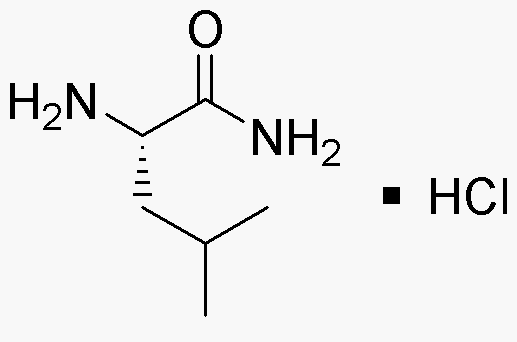L-Leucine amide hydrochloride is widely utilized in research focused on:
- Protein Synthesis: This compound plays a crucial role in stimulating protein synthesis, making it valuable in sports nutrition and muscle recovery formulations.
- Pharmaceutical Development: It is used in the formulation of drugs aimed at treating metabolic disorders, enhancing the efficacy of therapeutic agents.
- Cell Culture: In laboratory settings, it serves as a supplement in cell culture media, promoting cell growth and viability for various biological studies.
- Neuroprotective Research: The compound is investigated for its potential neuroprotective properties, contributing to studies on neurodegenerative diseases.
- Cosmetic Applications: It is incorporated into skincare products for its moisturizing properties, helping to improve skin hydration and texture.
General Information
Properties
Safety and Regulations
Applications
L-Leucine amide hydrochloride is widely utilized in research focused on:
- Protein Synthesis: This compound plays a crucial role in stimulating protein synthesis, making it valuable in sports nutrition and muscle recovery formulations.
- Pharmaceutical Development: It is used in the formulation of drugs aimed at treating metabolic disorders, enhancing the efficacy of therapeutic agents.
- Cell Culture: In laboratory settings, it serves as a supplement in cell culture media, promoting cell growth and viability for various biological studies.
- Neuroprotective Research: The compound is investigated for its potential neuroprotective properties, contributing to studies on neurodegenerative diseases.
- Cosmetic Applications: It is incorporated into skincare products for its moisturizing properties, helping to improve skin hydration and texture.
Documents
Safety Data Sheets (SDS)
The SDS provides comprehensive safety information on handling, storage, and disposal of the product.
Product Specification (PS)
The PS provides a comprehensive breakdown of the product’s properties, including chemical composition, physical state, purity, and storage requirements. It also details acceptable quality ranges and the product's intended applications.
Certificates of Analysis (COA)
Search for Certificates of Analysis (COA) by entering the products Lot Number. Lot and Batch Numbers can be found on a product’s label following the words ‘Lot’ or ‘Batch’.
*Catalog Number
*Lot Number
Certificates Of Origin (COO)
This COO confirms the country where the product was manufactured, and also details the materials and components used in it and whether it is derived from natural, synthetic, or other specific sources. This certificate may be required for customs, trade, and regulatory compliance.
*Catalog Number
*Lot Number
Safety Data Sheets (SDS)
The SDS provides comprehensive safety information on handling, storage, and disposal of the product.
DownloadProduct Specification (PS)
The PS provides a comprehensive breakdown of the product’s properties, including chemical composition, physical state, purity, and storage requirements. It also details acceptable quality ranges and the product's intended applications.
DownloadCertificates of Analysis (COA)
Search for Certificates of Analysis (COA) by entering the products Lot Number. Lot and Batch Numbers can be found on a product’s label following the words ‘Lot’ or ‘Batch’.
*Catalog Number
*Lot Number
Certificates Of Origin (COO)
This COO confirms the country where the product was manufactured, and also details the materials and components used in it and whether it is derived from natural, synthetic, or other specific sources. This certificate may be required for customs, trade, and regulatory compliance.


